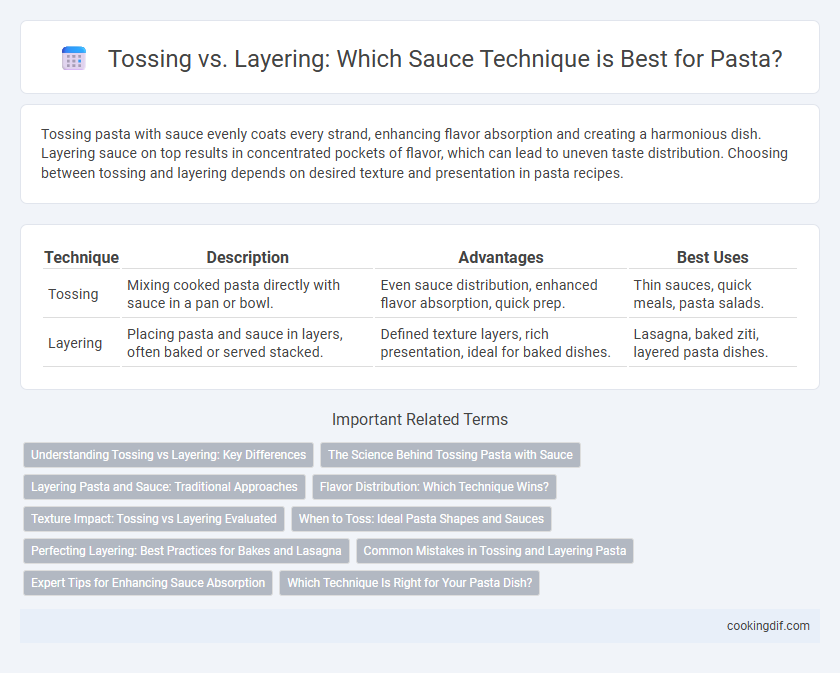Tossing pasta with sauce evenly coats every strand, enhancing flavor absorption and creating a harmonious dish. Layering sauce on top results in concentrated pockets of flavor, which can lead to uneven taste distribution. Choosing between tossing and layering depends on desired texture and presentation in pasta recipes.
Table of Comparison
| Technique | Description | Advantages | Best Uses |
|---|---|---|---|
| Tossing | Mixing cooked pasta directly with sauce in a pan or bowl. | Even sauce distribution, enhanced flavor absorption, quick prep. | Thin sauces, quick meals, pasta salads. |
| Layering | Placing pasta and sauce in layers, often baked or served stacked. | Defined texture layers, rich presentation, ideal for baked dishes. | Lasagna, baked ziti, layered pasta dishes. |
Understanding Tossing vs Layering: Key Differences
Tossing pasta with sauce evenly coats each strand, enhancing flavor absorption and texture consistency, while layering involves placing sauce between pasta layers, creating distinct flavor pockets and a richer mouthfeel. Tossing promotes uniform heat distribution and quick ingredient integration, ideal for dishes like spaghetti aglio e olio, whereas layering suits baked pastas like lasagna, allowing sauces to meld during baking. Understanding these techniques affects sauce penetration, presentation, and overall taste experience in pasta preparation.
The Science Behind Tossing Pasta with Sauce
Tossing pasta with sauce ensures even coating by allowing the starches released from the pasta to bind with the sauce, creating a smoother, more cohesive texture. This technique maximizes flavor absorption and prevents the sauce from settling unevenly, enhancing the overall taste experience. The agitation during tossing increases the sauce's adherence by evenly distributing moisture and heat, which intensifies the pasta's flavor profile.
Layering Pasta and Sauce: Traditional Approaches
Layering pasta and sauce involves alternating layers of cooked pasta and sauce in a baking dish, allowing flavors to meld as they bake together. This traditional technique creates a cohesive dish where each bite combines tender pasta infused with rich sauce, often enhanced with cheese or herbs. Classic recipes like lasagna showcase the depth achieved through careful layering, emphasizing texture contrasts between soft pasta sheets and savory fillings.
Flavor Distribution: Which Technique Wins?
Tossing pasta with sauce ensures even flavor distribution as each strand is coated uniformly, enhancing every bite with consistent taste. Layering sauce, often found in baked pasta dishes, can create pockets of intense flavor but may result in uneven seasoning throughout the dish. For optimal flavor balance, tossing typically wins by allowing sauce to thoroughly penetrate and flavor the pasta.
Texture Impact: Tossing vs Layering Evaluated
Tossing pasta with sauce ensures even coating on each strand, enhancing the overall texture by allowing the sauce to penetrate and cling uniformly, resulting in a balanced flavor and moist consistency. Layering sauce over pasta creates distinct texture contrasts, with saucy and drier sections, offering bite variation but potentially uneven flavor distribution. Understanding these techniques' impact on texture aids in achieving the desired mouthfeel and taste experience in pasta dishes.
When to Toss: Ideal Pasta Shapes and Sauces
Tossing pasta with sauce works best for shapes like penne, fusilli, and farfalle that have grooves or holes to capture the sauce evenly. This technique suits smooth, emulsified sauces such as pesto, carbonara, or simple olive oil and garlic blends, ensuring every bite is flavorful. Thin, delicate pasta like spaghetti benefits from tossing, allowing the sauce to coat strands uniformly without overwhelming the texture.
Perfecting Layering: Best Practices for Bakes and Lasagna
Perfecting layering in pasta bakes and lasagna involves evenly spreading sauce between pasta sheets to ensure consistent moisture and flavor absorption. Using a ladle to distribute sauce with precision prevents sogginess and creates balanced layers that enhance texture. Allowing the sauce to seep into each layer before adding cheese or pasta improves overall cohesiveness and bake quality.
Common Mistakes in Tossing and Layering Pasta
Tossing pasta with sauce often leads to uneven coating or mushy texture when done improperly, especially if the pasta is not drained properly or the sauce is too thick. Layering pasta, commonly used in dishes like lasagna, can result in dry or dense layers if sauces and cheeses are not evenly distributed or if the pasta sheets are not sufficiently cooked. Both techniques require careful attention to sauce consistency and pasta texture to avoid these common mistakes and ensure a balanced, flavorful dish.
Expert Tips for Enhancing Sauce Absorption
Tossing pasta directly with sauce ensures every strand is evenly coated, maximizing flavor absorption through consistent heat distribution and surface contact. Layering sauce, by pouring it between pasta layers, allows for a textural contrast where some bites are richly sauced while others remain lighter, ideal for baked pasta dishes. For optimal absorption, cook pasta al dente, reserve pasta water to adjust sauce consistency, and vigorously toss to emulsify the sauce, enhancing cling and depth of taste.
Which Technique Is Right for Your Pasta Dish?
Tossing pasta with sauce ensures even coating and flavor integration, making it ideal for lighter, oil-based or creamy sauces that cling well to the strands. Layering sauce, often used in baked pasta dishes like lasagna, allows for distinct flavor layers and texture contrasts between pasta sheets and sauce components. Choosing between tossing and layering depends on the desired texture and presentation, with tossing enhancing sauciness and layering emphasizing structured, hearty servings.
Tossing vs layering for sauce technique Infographic

 cookingdif.com
cookingdif.com